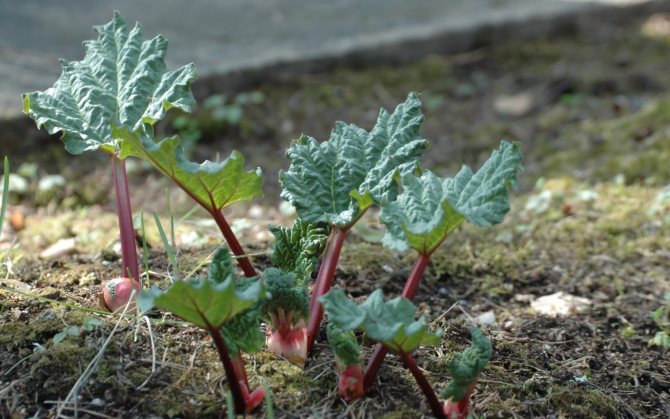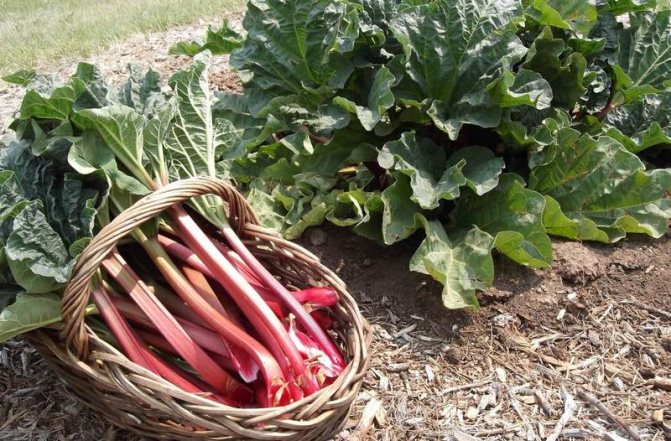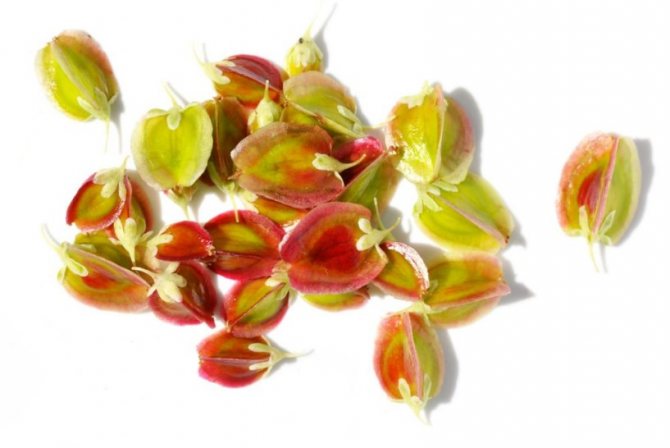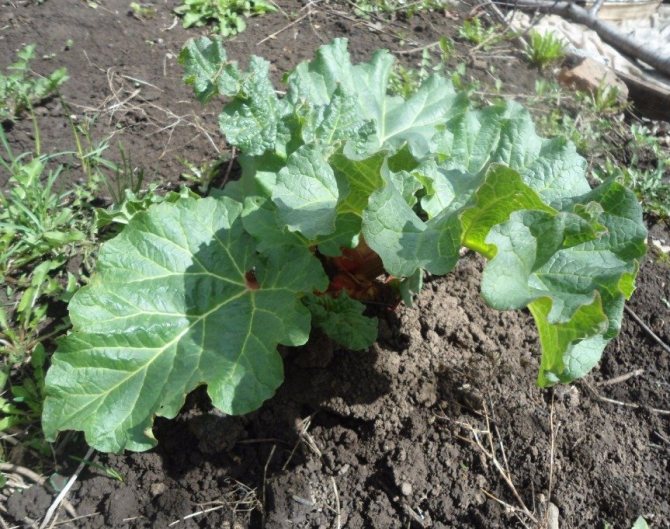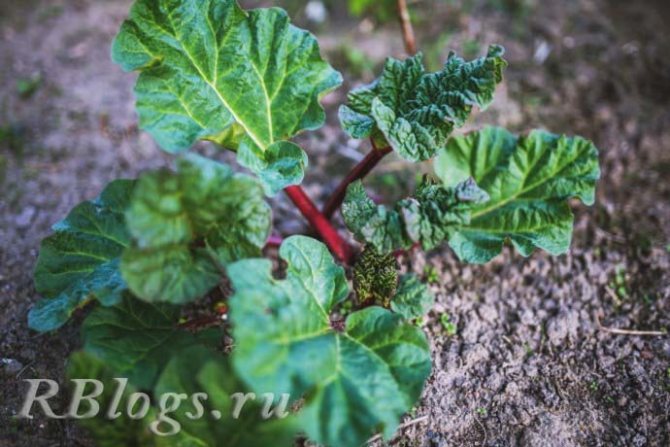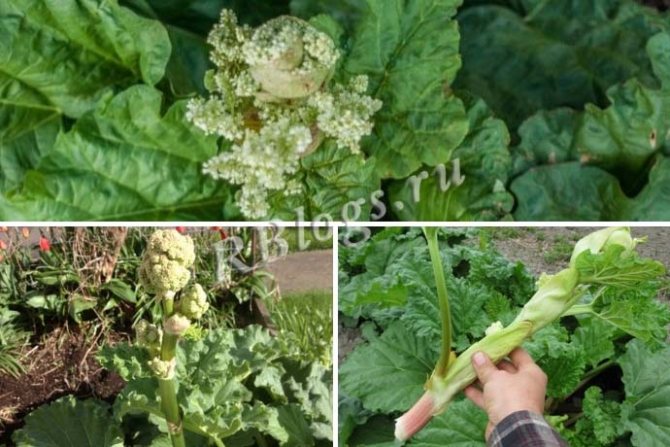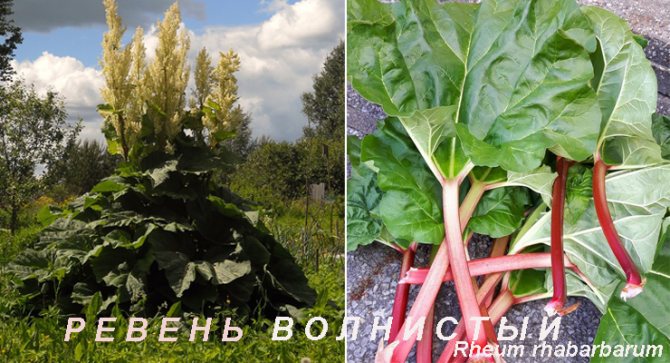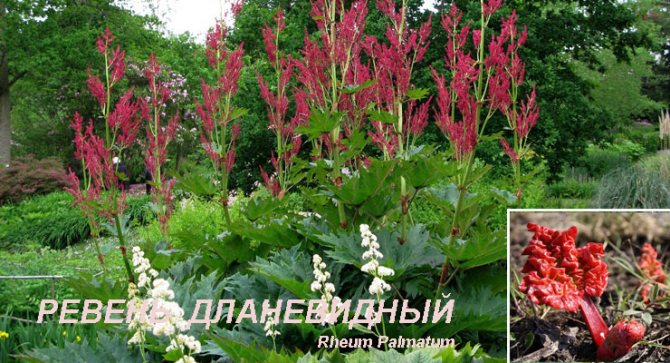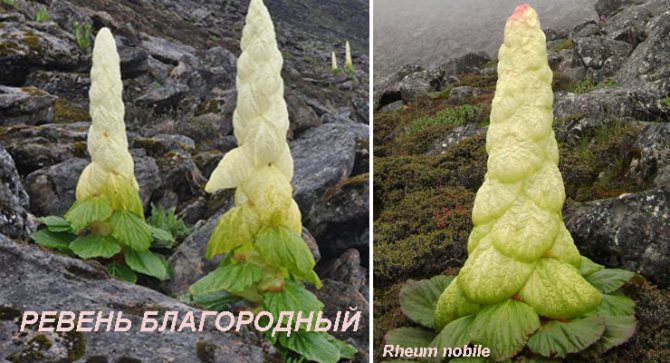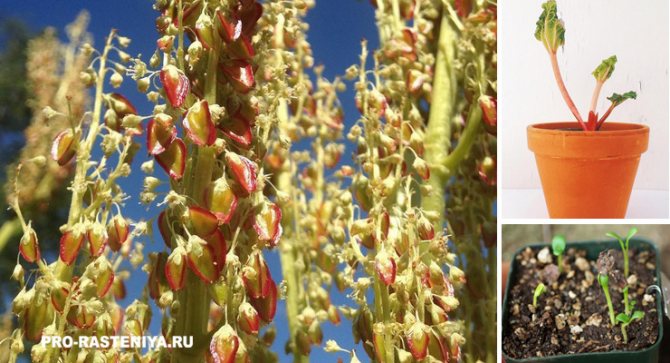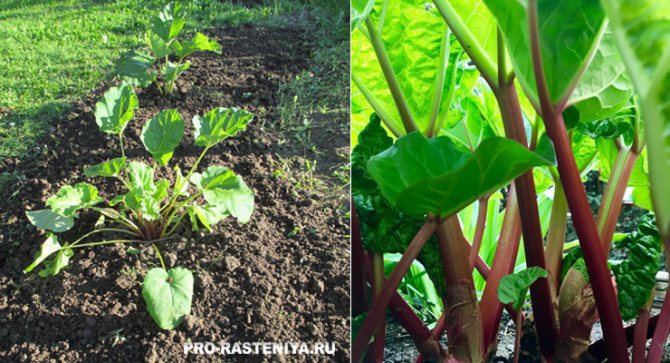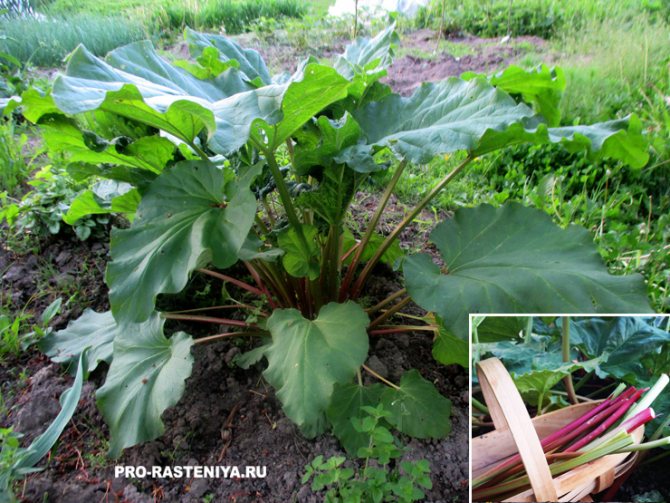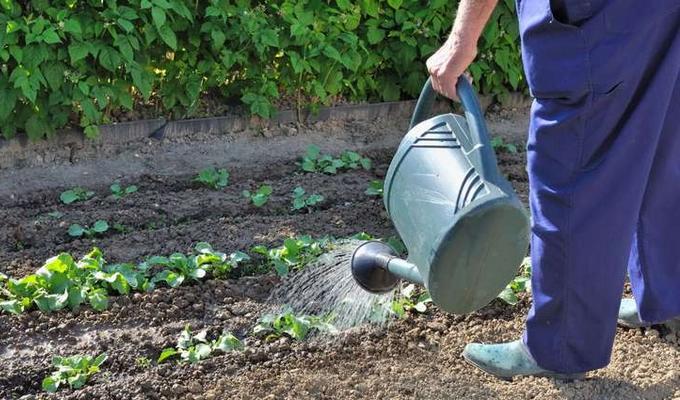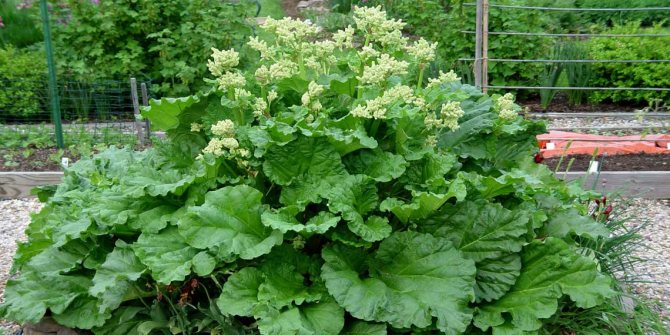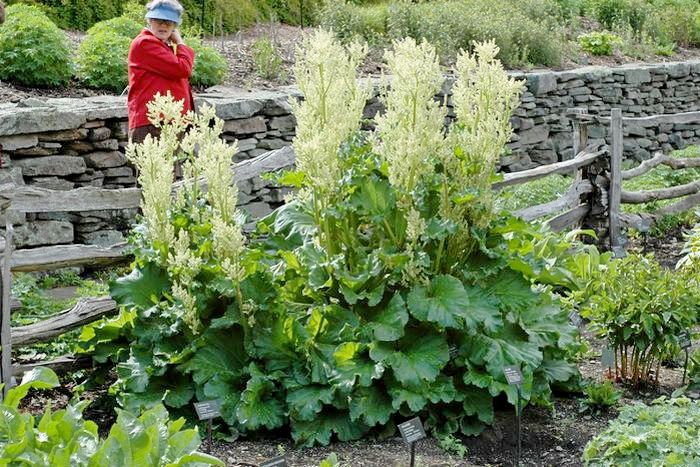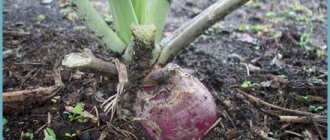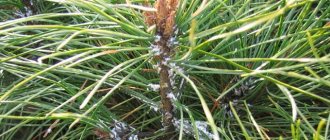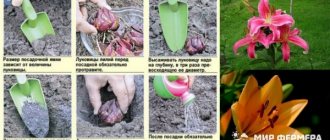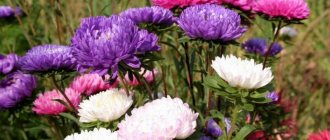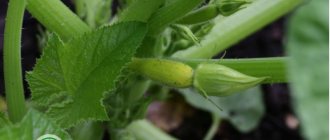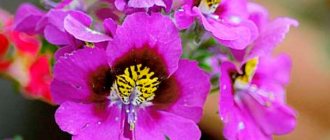Succulent rhubarb leaves and stalks are a great addition to your daily diet. Growing rhubarb outdoors is easy if the right crop conditions are created. The material from our article will tell you how to grow rhubarb in the country, take care of it and harvest it.
You will find out which period is considered the most successful for planting a crop, and what kind of care the plants need during different growing seasons.
- Features of the
A brief description of rhubarb
Rhubarb (Rheum) is a perennial and member of the buckwheat family. The plant is large, reaches 3 m in height and is formed from a basal rosette of leaves growing on long petioles. Thick, fleshy, reddish petioles are used for food. Their shape is cylindrical or multifaceted, reaching 4 cm in thickness.

The leaves are palmate-lobed, whole, rather large in size with jagged or wavy edges. The color is usually dark green with reddish veins. In early summer, flowering begins: a large paniculate inflorescence is formed with small flowers from white to red (depending on the variety). Later, the fruits are formed - triangular brown nuts.
Rhubarb can grow in all regions of our country, including Siberia and the Far East, since it tolerates cold well. Another distinguishing feature is its high shade tolerance. It grows in one place for up to 10 years and, expanding, forms dense thickets. But it needs a transplant, as the soil is depleted and the plant becomes shallow.
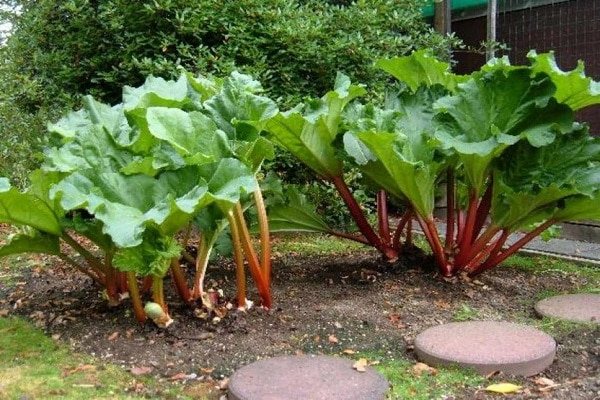

Reproduction is carried out by seedling and dividing the roots. Agricultural technology depends on the variety and biological characteristics of the plant, but does not present any particular difficulties for the vegetable grower.
Rhubarb stalks taste like a sour apple. In terms of the content of nutrients, they are also not inferior to this fruit. It is used as a medicinal product for a number of diseases.
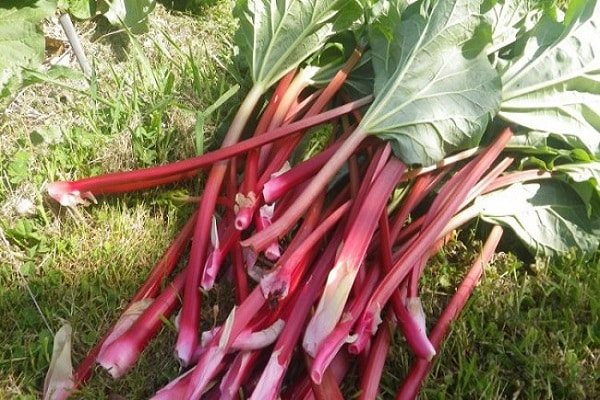

Breeding methods
Rhubarb can be propagated by seeds or dividing. Each of the methods has a number of nuances.
Seeds
To get seeds from grown plants, you need to leave the most powerful peduncle to develop in three-year-old specimens. When the inflorescences become dark in color, the seeds are collected and dried.
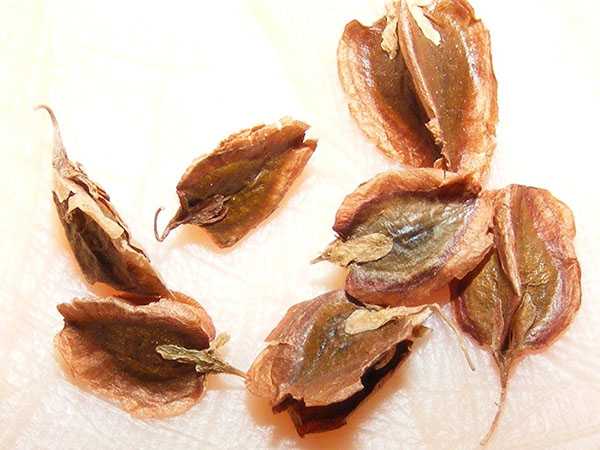

By dividing the bush
The division of the bushes is carried out during the spring or at the beginning of autumn, before the onset of the first cold snaps. A bush is dug out of the ground and divided into several equal parts. A powerful root with a pair of large buds is suitable for planting. When planting, the buds of plants are buried 1.5 cm into the soil.
Main varieties and varieties
Up to 50 varieties of rhubarb are known, most of which grow in their homeland - in Asia. Most vegetable growers are in favor of getting produce in early spring, when there is a lack of greens and vitamins. But in the fall, juicy petioles will come in handy for making homemade preparations. Based on this, a variety is selected. Most often grown:
- Altai dawns (early ripening) form a spreading rosette of leaves that sit on reddish petioles weighing 80-120 g. It has an excellent sweet-sour taste. Harvesting is done 30 days after the plant has started to grow.
- Large-petiolate (early maturing) has a high yield, low susceptibility to diseases. It tolerates low temperatures well. The petioles are characterized by tender and sweet flesh with a slight sourness.
- Victoria (early maturing) refers to high-yielding varieties, which quickly grow petioles, reaching a mass of 200-250 g. Initially, they are red, but over time they become green. Forms peduncles early, they must be cut out immediately.
- Ob (mid-season) forms a large rosette of slightly corrugated leaves with pink petioles. They have a delicate sweet and sour taste. The cold-hardy variety tolerates excess moisture, but does not tolerate drought.
- Ogresky-13 (mid-season) forms a compact leaf rosette with dark green foliage. Weakly ribbed petioles are red in color and some specimens increase their weight to 300-350 g. The variety is resistant to shooting and forms few peduncles.
- Giant (late ripening) has an impressive appearance. Rhubarb with dark red petioles is large in size. The popularity of the variety is noted due to the late return of the harvest and excellent taste.
In order to collect juicy petioles during the summer, several varieties must be planted on the site, which have different ripening periods.
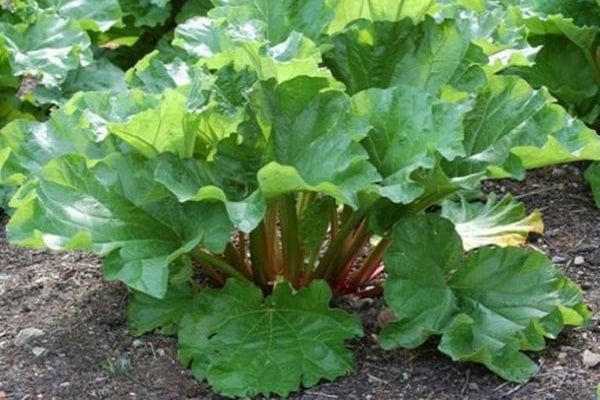

The best early maturing rhubarb varieties
About 40 species of rhubarb are known, but the most common for cultivation are:
- Tangut;
- wavy;
- compact;
- petiolate.
In Russia, experienced gardeners distinguish several of the best early varieties.
| Name | From growing petioles to harvesting | Description |
| Large petiolate | 40-45 days | The plant is compact, with dark green wavy toothed leaves. The petioles are large, 45-70 cm long, crimson, with pronounced pigment stripes, juicy, sweet and sour, with tender pulp, little fiber. 1.9-2.5 kg / m2 of petioles are collected from 1 m2. The variety is resistant to fungal diseases. |
| Stubborn | 41-44 days | The rosette of leaves is raised, the petioles are large, 50-55 cm long, light green with anthocyanin coloration at the base, the weight of one petiole is 100-180 g. The variety is very productive - 4-5.5 kg / m2. It is moderately affected by pests and leaf ascochitis. |
| Zaryanka | 39-45 days | For the first collection, 2-2.5 kg of petioles are removed from the plant. Petioles 2/3 of the length with cherry pigmentation, retain their color when preserved. |
SAVE USEFUL INFORMATION ON YOUR FAVORITE SOCIAL NETWORK PAGE:
Combining rhubarb with other plants
Rhubarb grows well next to salads, representatives of cruciferous vegetables (cabbage), does not mind the neighborhood with spinach and beans. It is oppressed by the fruit and vegetable crops located next to it. For example, he is unfriendly to members of the nightshade family, radishes, onions, legumes, carrots and a number of other plants that live in the beds.
It is advisable to plant the bushes separately. And since the petiole culture loves partial shade, it will perfectly fit into the fence, close the area near outbuildings or be located in a corner in a shaded corner of the garden.


Planting dates
The planting date is related to the breeding method. Many growers prefer the vegetative method, as the seeds can grow wild forms of rhubarb. Landing dates:
- the plant reproduces by the rhizome in the spring-autumn period;
- seeds are sown before winter, when the ground freezes;
- seedlings are sown in March.
See also
How to preserve and prepare tarragon for the winter at home, drying and freezingRead
When dividing the rhizome, the harvest of tender petioles will not keep itself waiting long, and the seedling method will allow you to get a bush 20-30 cm high, capable of overwintering normally.
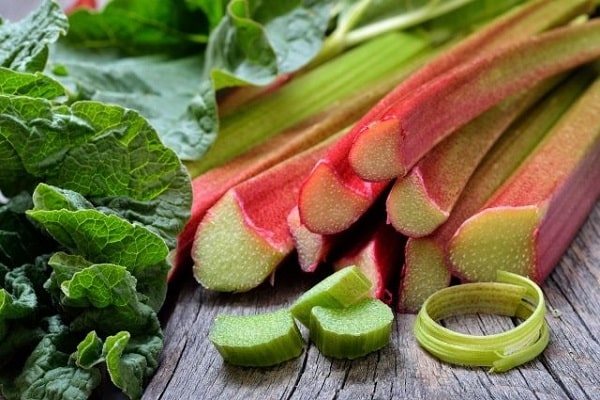

Rhizome planting
How to choose a healthy mother bush in the country? For reproduction and subsequent cultivation, it must meet the following characteristics:
- meet varietal qualities;
- be large and strong;
- be 4-5 years old;
- form few peduncles.
There is no need to grow many plants. Usually rhubarb is not grown in large quantities; 2-3 bushes are enough for one family.
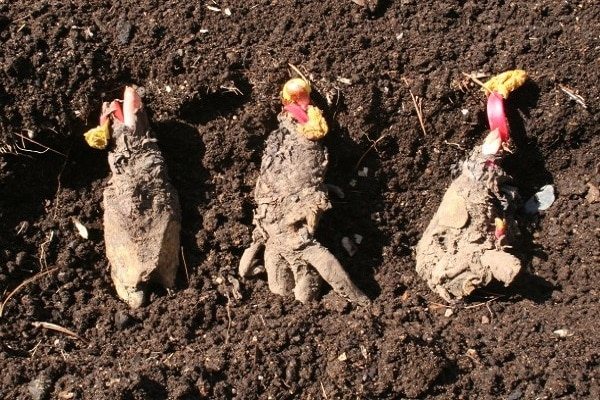

Preparing for landing
By the time of transplantation, the landing pits should be ready. Their size is approximately 50 × 50 cm, and the distance between the bushes is 50-70 cm. Young bushes can be planted in the autumn-spring period.
Rhubarb gives juicy petioles in fertile areas and grows in one place for a long time, therefore, they bring into the planting pits: 1 bucket of peat, 1 bucket of humus, 0.5 liters of wood ash mixed with earth.
When applying mineral fertilizers, the pits are prepared in advance so that the granules have time to dissolve and not burn the root system.
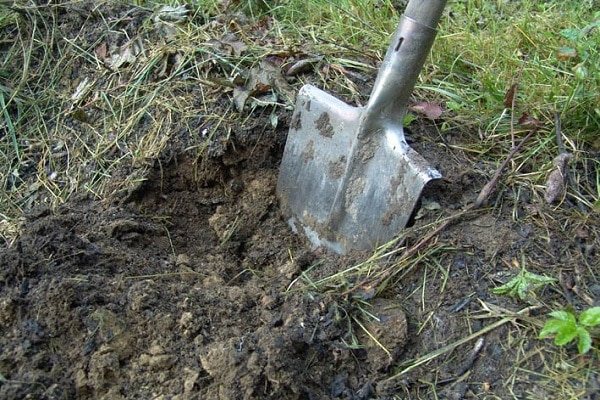

Rhizome division
The division procedure goes through several stages:
- we shovel the earth from the bush;
- we select a part of the delenka with 2-3 kidneys;
- cut it off from the main bush;
- we plant the division on a new site.
It is not necessary to process the cut sites: rhubarb has good survival rate and grows quickly.
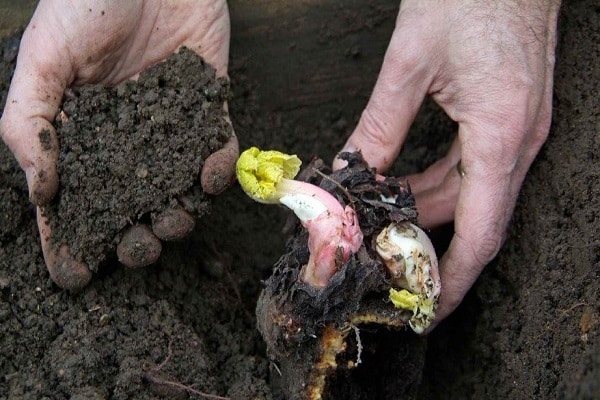

Landing options
Since the green culture prefers soil saturated with nutrients, a mixture of peat and humus is poured onto the bottom of the planting pit. A seedling is placed in the center, the roots are spread over the surface and covered with a small layer of peat soil. Next, add earth mixed with ash.
The embedding depth of the buds is about 3 cm. Rhubarb should be well buried without leaving the buds on the surface. After planting, shed and mulch the soil. In the early stages of growth, frequent watering is not necessary, since young bushes consume a little moisture.
Another planting option is when fresh manure is used instead of humus. It is placed at the bottom of the pit, covered with peat chips on top and the roots of the seedling are placed. From above they are covered with earth mixed with ash. The roots are not burnt, as there is a peat layer. Gradually, the manure decays and releases the nutrients. As in the first case, abundant watering and mulching are required.
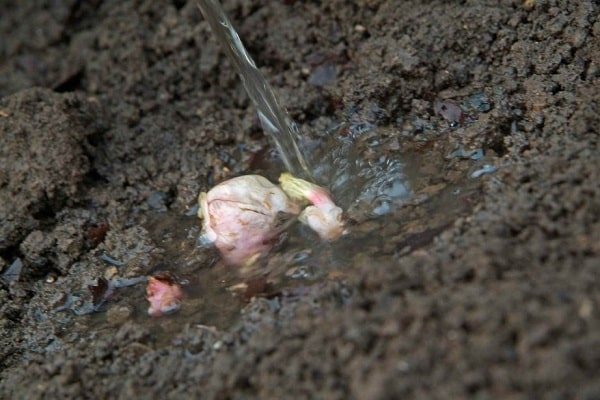

Planting rhubarb seeds
Seeds are sown directly on the site before winter or used to obtain seedlings. In the first case, the seed material does not need to be processed, since during the winter it undergoes stratification, is saturated with moisture and actively grows. But it will take 2 years to wait for full-grown, adult plants.
The use of the seedling method is preferable, since it significantly reduces the growth time and obtaining petiole products. There is always a small, semi-shaded area in the garden where you can plant several specimens of rhubarb.
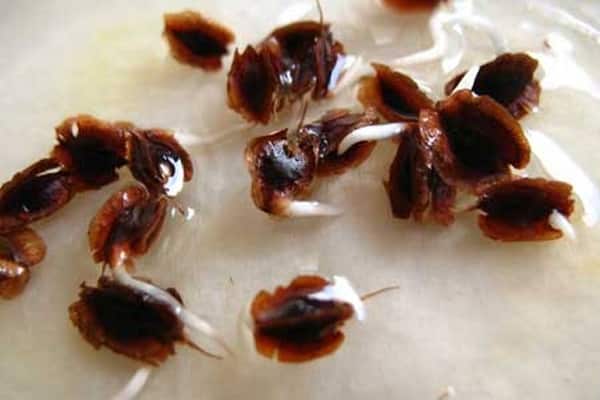

Seed preparation for sowing
Dry seeds can also be sown, but they germinate for 16-20 days. This period of time is significantly reduced if pre-processing is carried out:
- pour melted or pure water into a small container, adding any growth stimulant (Epin, aloe juice);
- keep the seeds in water for 48 hours and drain it;
- lay out on a damp cloth and roll it up;
- we leave for 10 days in the refrigerator at a temperature of 0, + 5C:
- then leave in a warm place until germination.
The planting material treated in this way gives seedlings after a week. After sowing, seedlings appear in 8-12 days, that is, twice as fast as when sown with dry seeds.
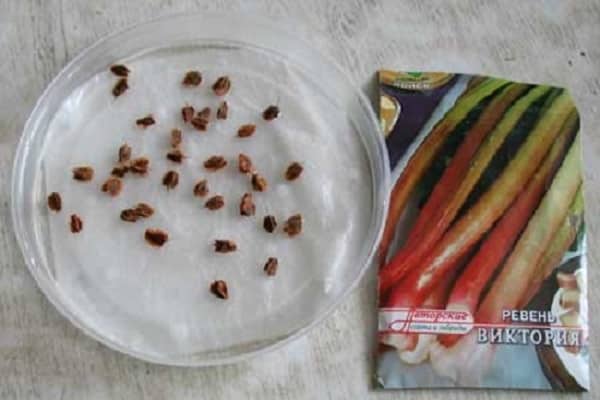

Sowing in open ground
If sowing is done with germinated seeds, then the best time is the last days of spring. Rhubarb gives good and friendly shoots when the ground warms up to +16, + 20C. The soil is prepared in advance, into which they add 1 sq. M. 1-2 buckets of humus or compost and 0.5 liters of ash. For seeds, grooves up to 3 cm deep are prepared and planted after 3-5 cm.
When three real leaves appear, the seedlings are thinned out by placing the bushes at a distance of 20 cm from each other.After 1-2 years, when the plants become adults, they are planted according to the same principle as the delenki.
Early sowing can lead to the death of young seedlings, if there is a possibility of return frosts. The hatched leaves die at a temperature of -2, -6C.
See also
Growing, planting and caring for tarragon grass in the open field at home, how to propagate tarragonRead
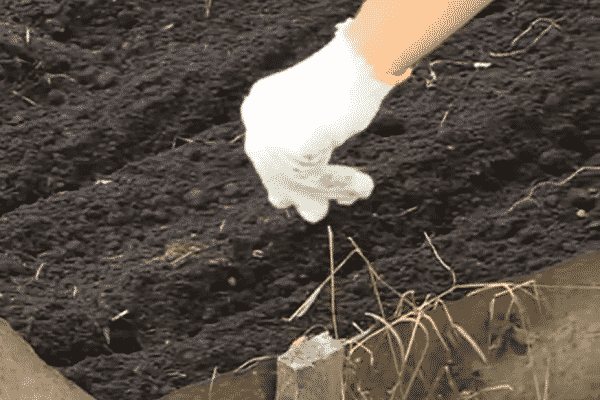

Sowing seedlings
It is advisable to sow seeds in the second half of March, when the daylight hours are long enough. When growing seedlings, you should follow a few simple rules:
- we prepare a loose and nutritious soil mixture or use a ready-made one;
- when shoots appear, we put the box in a bright and cool place;
- water and feed twice a month (for example, with Fertik Lux solution);
- in the phase of 2 leaves, we plant them in cups;
- a week before planting in the ground, we accustom the seedlings to natural conditions, gradually accustoming them to fresh air.
When the seedlings get stronger and get used to the natural environment, they are planted in the ground. Usually the planting date is the end of May, beginning of June.


How to care for an unpretentious crop in the garden
Rhubarb is an unpretentious plant. It is easy to understand how to properly care for it outdoors. Due to the large burdock-like leaves, weeds rarely form around the crop. But they must be removed during the early growth period. It is at this time that there can be many of them. They have a bad effect on the development and formation of the green part.


In order for rhubarb to develop faster, you need to periodically loosen and mulch the soil around the plant. Watering is done at least 2 times a week if the weather is dry. In the heat, the procedures are more frequent. In the rain, it is better not to water the perennial. Bloom should not be allowed. It has a bad effect on the formation of petioles, taking a lot of strength from the rhizome.
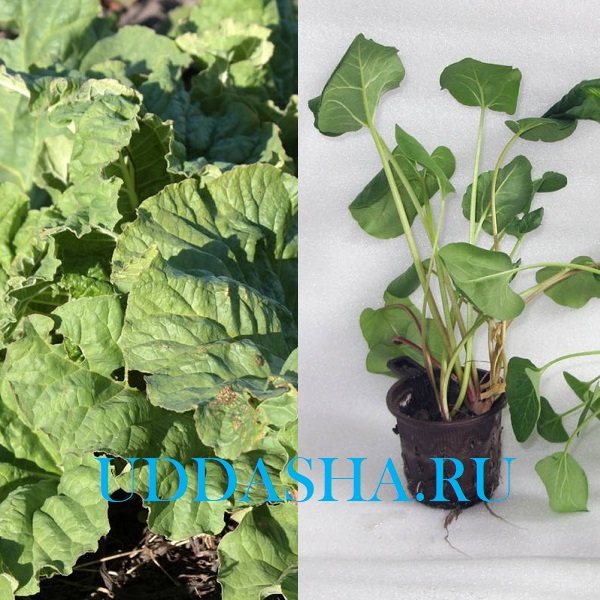

For the whole season, only three dressings are made. The first is at the stage of formation of the first leaves. At this time, the plant needs organic matter. The second - during the period of active growth and the third - in the midst of autumn. Rhubarb prefers organic compounds. It can be fertilized with mullein diluted in water, rotted manure or stale compost. In summer, it is best to focus on minerals. Fertilizers should not contain a lot of nitrogen, as this provokes violent flowering. It is not desirable if you want to get a bountiful harvest.
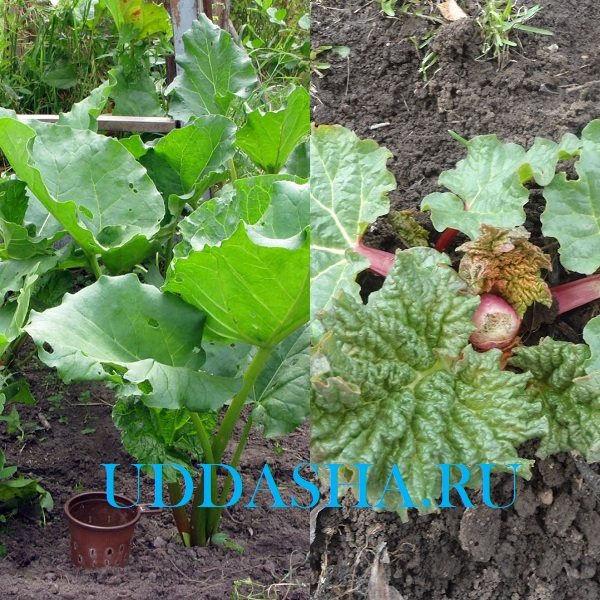

Of the pests, rhubarb often affects the buckwheat flea and the rhubarb bug. But, this is only if the recommendations of agricultural technology are violated. In conditions of strong waterlogging, the plant suffers from gray rot and powdery mildew. A dense planting of rhubarb can also cause a fungal infection.
Look at the video on how to properly grow rhubarb from seeds in the open field - the gardener reveals all the secrets of agricultural culture:
Features of rhubarb transplant depending on the season
It is best to plant rhubarb in a new place in the fall a month before the cold weather comes or in early spring until the foliage begins to grow. These are the most convenient periods, since all the juices are collected in the roots and the leaves do not draw out nutrients and do not evaporate moisture. The roots at this time do not feed the plant and it tolerates transplantation painlessly.
In summer, the bush grows, the process of photosynthesis and nutrition takes place in the leaves, so the transplant is extremely difficult and rhubarb does not always take root, reacting extremely sensitively to mechanical damage. At the same time, it will not work to grow a healthy bush.
Young bushes and seedlings lend themselves to summer transplantation, which are transferred to a new site with a large clod of soil. They need regular watering and careful shading.
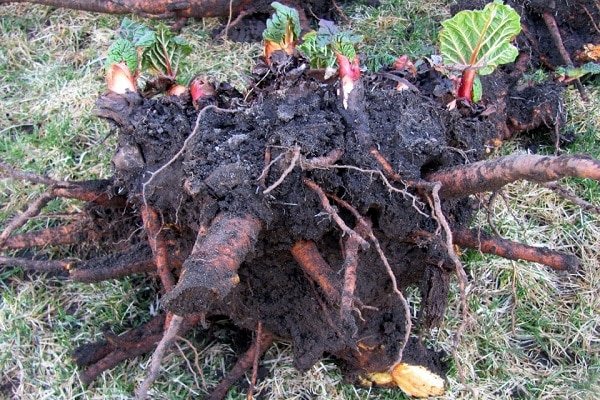

In the first year of planting, petioles must not be cut. The plant has not yet reached maturity and will weaken significantly if a few leaves are lost.Cutting is done only for 2-3 years of growth.
Rhubarb care
It is not difficult to care for the stalked culture. Traditional activities are carried out: watering, weed removal, top dressing, loosening. Additional ones include cutting of peduncles.
Fertilizing and fertilizing plants
It is enough to feed a green crop 3 times a season, since its fertilizer requirements are minimal. Rhubarb is responsive to organic fertilizing, of which the infusion of mullein (1: 5), chicken manure (1:10) or nettle and weeds is most often used.
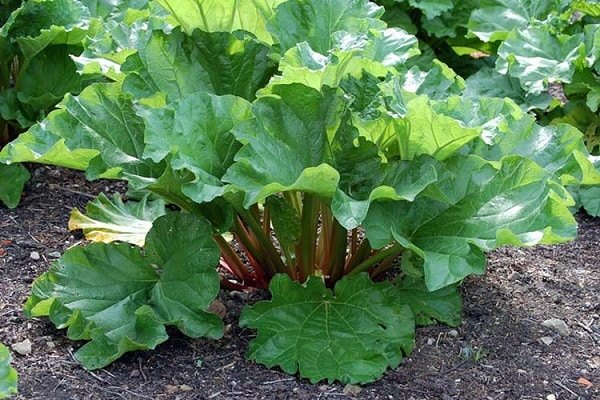

If necessary, add Kemira-universal complex fertilizer or nitrofosku. Ash, which is added dry during loosening before watering, is also suitable for these purposes. Application rate - 1 glass of ash per 1 sq. M.
Nitrogen fertilizers contribute to the growth of leaf mass, but they need to be applied in the spring, in the summer they contribute to the formation of peduncles.
Watering and weeding
Since the plant is powerful, it shades the soil and the weeds under it practically do not grow and there are no difficulties with a large amount of weed vegetation.
Rhubarb needs regular watering, without which fleshy petioles do not grow. With a moderately rainy summer, 3-4 waterings per season are enough, but they should be plentiful. Thanks to water, oxalic acid practically does not accumulate in the petioles.
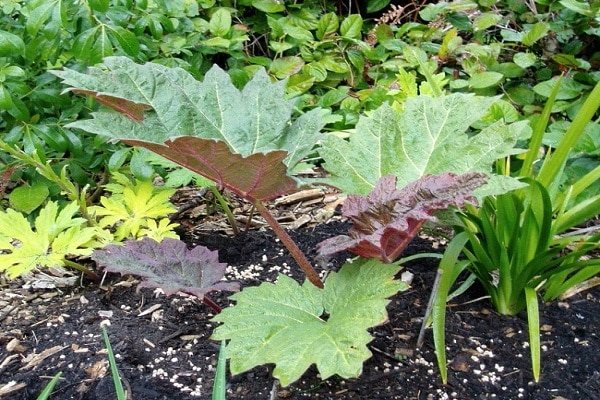

Protection against diseases and pests
Rhubarb is practically not attacked by pests and rarely gets sick. In some cases, "raids" of buckwheat fleas or rhubarb bugs are observed. Of the diseases, the most dangerous are gray rot and downy mildew, which most often develop with thickened plantings.
For reliability, you can carry out a three-time treatment with Fitosporin, and use folk remedies for pests. If the disease is severe, then the plants should be removed and burned so that neighboring plantings do not suffer.
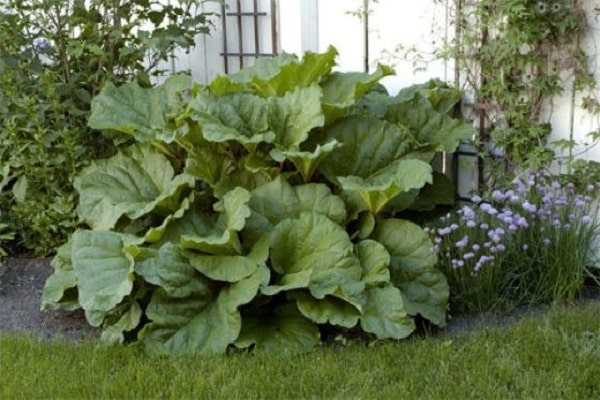

Diseases and pests
The perennial plant is highly resistant to diseases and pests. However, sometimes rhubarb can affect powdery mildew, root rot or ascochitosis, and from insects for culture, rhubarb bug and buckwheat fleas are especially dangerous.
The best prevention of disease is to follow all the rules for growing rhubarb. To prevent diseases and eliminate insects, the plant is recommended to be treated with fungicides and insecticidal preparations once a season. But this should be done only after harvesting so that the rhubarb stalks do not absorb toxic substances.
Harvesting rules
The crop can be harvested in the second year of growth in May-June with a petiole length of 20-25 cm. The first, earliest harvests are the most valuable, since they contain the greatest amount of nutrients. During the season, juicy stems are harvested several times until early August.
The petioles are not cut off, but carefully broken out so as not to damage the growth shoots. To do this, the petiole is scrolled several times and pulled out with a jerk downward, otherwise the rhizome will suffer. When harvested, the main rosette of leaves is left on the plant. This way the bush will not weaken or deplete.
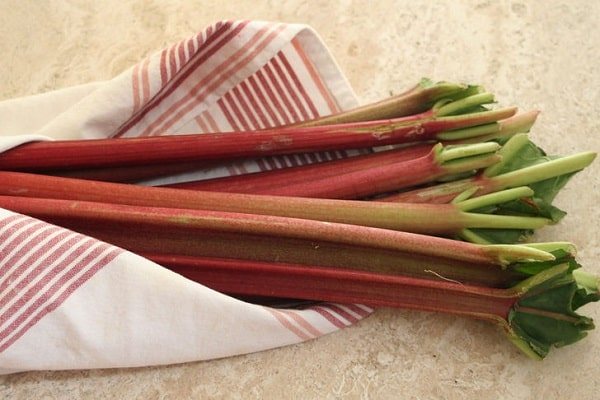

Only fresh shoots of rhubarb are useful, and in mature ones there is a high concentration of oxalic acid, which is not useful for the body. Leaves and roots are not eaten.
If southerners have a lot of vitamin crops that produce products in early spring, then Siberians have little choice. In case of spring vitamin deficiencies, rhubarb stalks will help out perfectly, they can be cooked in soups, added to salads and compotes. And if there is a place for a couple of bushes on the site, then early vitamin products will not be long in coming.
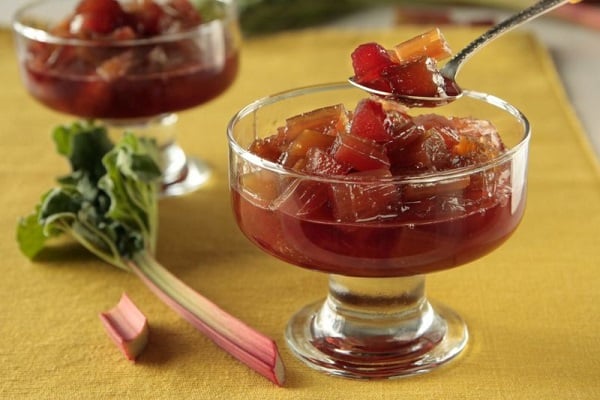

Useful properties of rhubarb
Rhubarb is a healthy crop, the stems and greens of which contain numerous vitamins and minerals
... In young petioles, citric and malic acid, vitamins B and C, iron, potassium and other components useful for our body are present in large quantities.You just need to remember that if you are late with the harvest, the stems will coarsen, they accumulate a large amount of oxalic acid, which makes them practically unsuitable for human consumption.
Rhubarb - photo


Another undoubted advantage of growing rhubarb on a personal plot is the fact that the first crop can be harvested in mid-May. This helps to solve the problems with vitamin deficiency and depletion of the body with the help of such fresh healthy greens, grown on their backyard without pesticides.
Regular consumption of young rhubarb stalks has a positive effect on the state of the digestive system, tones up the muscles of the intestines, acts as a natural mild laxative, allowing to solve the problem of chronic constipation.

